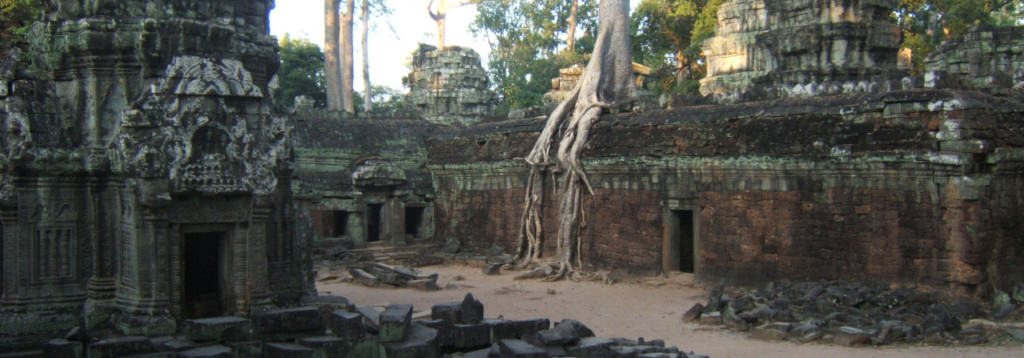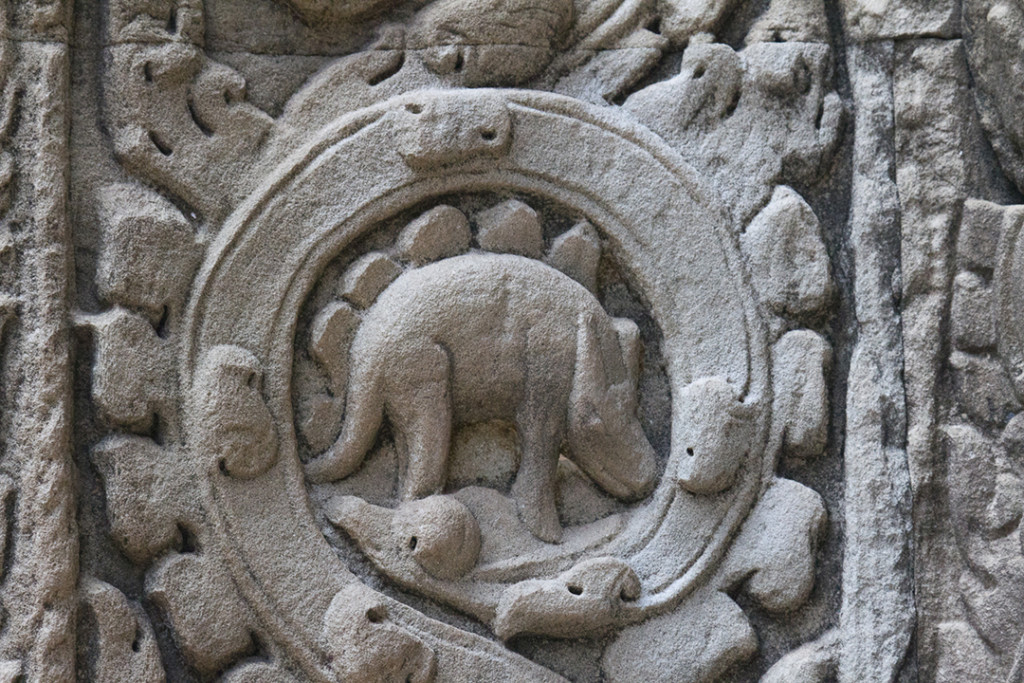
Domesticated Dinosaurs? Cambodian Stegosaur Gives New Clues
Those who have followed creationist literature for a while will no doubt be familiar with the Cambodian Stegosaur. For those who are not, the Cambodian Stegosaur refers to a bas relief found at the Ta Prohm temple at Angkor Wat.
The pillars of Ta Prohm are decorated by an ornate series of animal medallions, carved into the rockwork. Featured animals include many local beasts: buffalo, deer, monkeys, etc. There is one, however, that is a tad more exotic:

The “stegosaur” medallion. (Image source)
This carving, depicting what appears to be a kind of stegosaur, has puzzled secular archaeologists for many years. Although the carving itself is almost certainly genuine, this has not kept it from stirring controversy, as arguments regarding the true identity of this beast, dinosaur or otherwise, have raged even within creationist circles.
In January, a paper was published in Answers Research Journal that challenged the stegosaur theory1). In it, the argument was made that the “plates” running down the animal’s back were too deeply set to be considered part of the animal and were more likely a part of the background (the other carvings feature leaf-shaped designs set behind the animals themselves).
Taking further note of the relief’s large head (compared to the small heads of stegosaurs), lack of tail spikes, and strange “horns/ears,” it was concluded that the animal bore little actual resemblance to a stegosaur and was more likely a boar, rhino, chameleon, or some other animal (the paper is deliberately vague in its conclusion here).
The Need For Caution
It is important for us, as Christians, to be careful with how we weigh evidence – especially when that evidence excites us.
While evidence for dinosaur-and-man coexistence does exist, there are plenty of cases where such evidence has proven to be fake or misidentified. We do an injustice to the genuine artifacts and to the study of creation in general when we too easily fall for frauds and mistakes. Therefore, we must exercise caution before accepting any new claim or evidence as fact.
With this warning in mind, how should we view this carving? Is the Cambodian Stegosaur, as the paper above suggests, “another argument Creationists should not use?”
New Data, New Perspectives
A few days ago, a new paper was published in Answers Research Journal2), addressing many of the concerns brought up by the first. In this case, the author traveled to Cambodia and examined the carvings first-hand, instead of using only photo reference, as was the case with the first paper (a shortcoming readily acknowledged by the first paper’s author).
Regarding the back plates, measurements were taken, comparing the depth of the plates to the depth of the background flourishes on other carvings. While the background flourishes remained relatively flat against the back plane, only 1mm in depth, the back plates were much thicker, reaching close to the level of the animal itself at 2.5mm, suggesting that they were indeed intended to be a part of the animal in question.

Depth measurements taken of floral backdrop (left) and the animal plates (right). Images taken from the original paper.
Answers to the other challenges come from a surprising place indeed: a second, larger stegosaur carving, found elsewhere in the temple.

Photograph of the second Ta Prohm Stegosaur (original photo above, traced for clarity below). Images taken from the original paper.
Although worn by age, we can clearly see the same chunky body shape, complete with tail and back plates. In this case, the head is of a more slender, stegosaurian shape, but we also, once more, observe a strange shape carved around its neck – likely a bridle of some kind. If these carvings were truly depicting domesticated stegosaurs (either by the Cambodians themselves or a neighboring civilization), it may explain some of the puzzling features of the first Ta Prohm dinosaur.
The “horns” and boxy head could very well be the animal’s bridle, coupled with a kind of muzzle-like device, necessary for controlling a beast so large-in-body and small-in-brain (other animals, such as horses are also depicted with their bridles among these same carvings).
Domestication may even explain the lack of tail spikes. Cambodian elephants often have their tusks removed before entry into public service (and, like our “stegosaur,” are depicted without these tusks in ancient artwork). Seeing as a reptile, waving foot-long spikes, would be at least as dangerous as a fully-tusked elephant, it is easy to imagine that young stegosaurs would have had their “thagomizers”3) filed or removed before doing the same.
Conclusions
For now, it would seem that science has vindicated the Cambodian Stegosaur. While future discoveries may build upon our current understanding of these artifacts, the dinosaurs of Ta Prohm offer us a rare glimpse into a world lost to the mists of time.
If you are interested in this subject, I encourage you to read the papers yourself (find first paper here, and the second here). Neither are very long or technical, yet cover their subjects in far more depth than we could hope to do here.
References
| ↑1 | Cedar, Joshua. “Is the Cambodian Stegosaur-like Carving Another Argument Creationists Should Not Use?” Answers Research Journal 10 (January 25, 2017). |
|---|---|
| ↑2 | Woetzel, David. “The Stegosaur Engravings at Ta Prohm.” Answers Research Journal 10 (September 13, 2017). |
| ↑3 | A casual, pseudo-academic term for the business end of a stegosaur’s tale, inspired by a classic Far Side cartoon. |
